|
|
|
Sort Order |
|
|
|
Items / Page
|
|
|
|
|
|
|
| Srl | Item |
| 1 |
ID:
134209
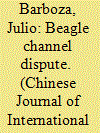

|
|
|
|
|
| Publication |
2014.
|
| Summary/Abstract |
The Beagle Channel dispute between Chile and Argentina presented great challenges to them. An award delivered by an arbitral tribunal did not manage to settle it. The crisis after the award brought the States to the brink of war. Only tenacious efforts by the Holy See to mediate between these two largely Catholic nations managed to calm tensions as well as a change in political climate allow the parties to finally settle the dispute. This paper describes and analyses the background to the dispute, the principles and arguments involved in the dispute, the decision of the Court of Arbitration, the crisis following the award, the papal mediation and the events that finally brought the dispute to an end. Some general comments will be offered in the last section.
|
|
|
|
|
|
|
|
|
|
|
|
|
|
|
|
| 2 |
ID:
132917


|
|
|
|
|
| Publication |
2014.
|
| Summary/Abstract |
The Beagle Channel crisis (1977-1984) unfolded in a global political context. In other words, it was never solely a bilateral matter between Argentina and Chile, as many analyses have suggested. From the international arbitration to the participation of a third actor (the Vatican), the role of the United States, the Falklands war and the United Kingdom, the Beagle crisis had pronounced regional and international dimensions. Domestic structures and international conditions affected the Argentinian and Chilean foreign policies to different degrees. The Beagle crisis resolution has been explained by reference to the key role played by the Vatican. However, recently declassified US documents and interviews with key actors reveal a different story. International sanctions for human right violations were affecting both countries' leverage in the international community and creating internal political problems. This finding suggests that both countries were keen to use mediation as a strategy to remove human rights violations from the US agenda.
|
|
|
|
|
|
|
|
|
|
|
|
|
|
|
|
| 3 |
ID:
134211
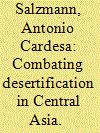

|
|
|
|
|
| Publication |
2014.
|
| Summary/Abstract |
This article appraises the Central Asian Countries' Initiative on Land Management (CACILM) as an innovative experience of regional co-operation to implement the Convention on Desertification. Despite high initial expectations, the actual implementation process has suffered drawbacks. The Central Asian countries' commitment and capacity to sustain this process depends heavily on international support. Moreover, the process's low political profile and the weak capacities of the Central Asian authorities to engage in meaningful transnational co-operation are significant hurdles to be tackled. At the same time, national and regional efforts to combat soil degradation and desertification have not yet been properly mainstreamed with other more consolidated processes for the sustainable management of natural resources, such as the IFAS. It is argued that this may be a possible solution for the future of CACILM.
|
|
|
|
|
|
|
|
|
|
|
|
|
|
|
|
| 4 |
ID:
133612
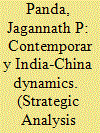

|
|
|
|
|
| Publication |
2014.
|
| Summary/Abstract |
This review essay examines the significance of India-China relations against the background of the current phenomenon of a multipolar world in the light of four recent publications on the subject. Tien-sze Fang's and Jeff M. Smith's works discuss the current facets of India-China relations, while William Antholis's and Carl J. Dahlman's works deal with the character and standing that India and China bring to their regional and global discourse. After reviewing the core of these books, this essay will seek to locate the dialogue and import of India-China relations in two constructive settings: first, the versatility of this relationship in a multipolar world order; second, why this relationship is important to the future of multipolar world politics. In the official idiom, India-China dynamics are not confined to the bilateral ambience. For example, a joint statement issued on the occasion of the visit of Premier Li Keqiang to India (May 20, 2013) records that 'There is enough space in the world for the development of India and China … As the two largest developing countries in the world, the relationship between India and China transcends bilateral scope and has acquired regional, global and strategic significance'.1 This official endorsement comes against the background that the year 2014 is the 60th anniversary of the occasion when the Panchasheel discourse was first enunciated.
|
|
|
|
|
|
|
|
|
|
|
|
|
|
|
|
| 5 |
ID:
132710
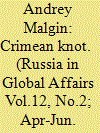

|
|
|
|
|
| Publication |
2014.
|
| Summary/Abstract |
Russia will have to deal with the effects of Crimea being part of an independent Ukraine for 23 years. A Crimean political and business elite has emerged with its own values, bonds, and relationships. Russia is not the motherland of an entire generation of Russian-speaking youth, but the motherland of their ancestors.
|
|
|
|
|
|
|
|
|
|
|
|
|
|
|
|
| 6 |
ID:
133091
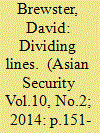

|
|
|
|
|
| Publication |
2014.
|
| Summary/Abstract |
Our mental maps of the world, including our perceptions of where regions begin and end, can have profound consequences on strategic behavior. For decades there has been a sharp division between what we understand to be the regions of South Asia and Southeast Asia. The line between them effectively cuts the Bay of Bengal in two. These perceptions have inhibited a proper analysis of the strategic dynamics of the area. This article argues that the Bay of Bengal increasingly matters as a strategic space. Like, the South China Sea, security issues in the Bay of Bengal and its littoral states need to be understood and addressed in a coherent manner.
|
|
|
|
|
|
|
|
|
|
|
|
|
|
|
|
| 7 |
ID:
134038
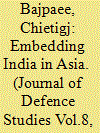

|
|
|
|
|
| Publication |
2014.
|
| Summary/Abstract |
The emergence of the Indo-Pacific as a new geopolitical frame ofreference is embedded in the growing strategic importance of themaritime domain and the rise of states that have demonstrated theability to 'transcend' their respective subregions. However, the Indo-Pacific remains a concept in its infancy, as evidenced by the fact that itcontinues to compete with alternative conceptions of regional space inAsia. This article argues that India has a vested interest in the survival ofthis new strategic geography as it serves to reinvigorate the momentumof its post-Cold War re-engagement with Asia under the aegis of its 'LookEast' and 'extended neighbourhood' policies. In this context, India shouldcontinue to cultivate the Indo-Pacific concept and ensure its embrace inthe region's evolving strategic vocabulary.
|
|
|
|
|
|
|
|
|
|
|
|
|
|
|
|
| 8 |
ID:
133522


|
|
|
|
|
| Publication |
2014.
|
| Summary/Abstract |
The paper seeks to assess the growing strategic importance of the Bay of Bengal and how this signifies for Bangladesh's imperative to develop strong maritime capabilities. With the growing significance of the Bay of Bengal, both the littoral and the extra-littoral countries are reassessing their interests in this region and reformulating respective strategies to ensure optimum benefit in their favour. After the verdict by the International Tribunal for the Law of the Sea (ITLOS) in March 2012, Bangladesh is now able to establish its claim over a significant area in the Bay of Bengal. These emerging realities are driving Bangladesh to develop capabilities to project effective control over its maritime zone and to ensure sustainable utilisation of marine resources. To respond efficiently, Bangladesh government has undertaken various initiatives including modernisation of the Bangladesh Navy with an aim of establishing a three dimensional force. The paper, based on secondary literature, finds that there is a growing interest among the countries in the Bay of Bengal area leading to a competitive strategic atmosphere for countries like Bangladesh. The findings also suggest that Bangladesh's drive for maritime capability building is a timely and pragmatic step which requires further strengthening in the coming years. Besides, the paper also argues that Bangladesh needs to formulate a comprehensive maritime strategy, focusing on diverse sectors of capability building. Some key areas can include empowering the coast guard, resource exploration and exploitation capacities, maritime infrastructure development for connectivity and seaborne trade as well as well-coordinated maritime governance.
|
|
|
|
|
|
|
|
|
|
|
|
|
|
|
|
| 9 |
ID:
134210


|
|
|
|
|
| Publication |
2014.
|
| Summary/Abstract |
This paper highlights several pivotal negotiating procedural steps that ultimately helped to promote the emergence of the final shape of the UNCLOS dispute settlement system. These steps include, for want of better phrasing, the following: (1) the package deal decision; (2) the consensus approach; (3) building consensus by privileging the best second choice; (4) building consensus by privileging the existing negotiating text through the rule of silence; and (5) failing consensus in the Negotiating Group, the Chairman presenting his own proposals as suggestions to the plenary. Needless to say, these steps are worthy of consideration by future treaty-makers and leaders in treaty-making when they are faced with complicated negotiating tasks, even if not as difficult as those during the monumental UNCLOS III.
|
|
|
|
|
|
|
|
|
|
|
|
|
|
|
|
| 10 |
ID:
155753
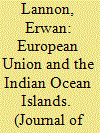

|
|
|
|
|
| Summary/Abstract |
The aim of this paper is to analyze, from a geostrategic, geo-economical and cooperation perspective, the relationships established by the European Union with the Indian Ocean Islands: Comoros, Madagascar, Maldives, Mauritius, Seychelles and Sri Lanka. The analysis also takes into consideration the cases of Mayotte, La Réunion, the Scattered Islands and the Chagos Archipelago. At strategic level, the EU has developed its actions in the Indian Ocean since the launching of the naval operation EU NAVFOR-ATALANTA in 2008, in response to the rising levels of piracy in the region. At geo-economic level, the implementation of the interim Economic Partnership Agreement with Madagascar, Mauritius, the Seychelles, and Zimbabwe is a major step, but other (potential) trade agreements, notably with Indonesia and India, have to be taken into consideration. At cooperation level, different EU’s (sub-)regional and bilateral actions are analyzed, including new specific programs and projects combining external and internal financial instruments in the region. The analysis of this complex network of relationships is the basis for identifying opportunities for developing a more ambitious and comprehensive strategy of the European Union vis-à-vis the Indian Ocean islands.
|
|
|
|
|
|
|
|
|
|
|
|
|
|
|
|
| 11 |
ID:
132709
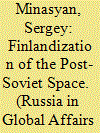

|
|
|
|
|
| Publication |
2014.
|
| Summary/Abstract |
Armenia, opting for self-restraint of its own accord, minimized its risks and losses. As to whether the Armenian-style Finlandization can be an example for other former Soviet republics would depend not only on their own choice.
|
|
|
|
|
|
|
|
|
|
|
|
|
|
|
|
| 12 |
ID:
071313


|
|
|
|
|
| Publication |
2006.
|
| Summary/Abstract |
In this paper we examine the changing perception of Central Asia and the Caucasus to Imperial Britain from the mid nineteenth to the mid twentieth centuries and consider the importance of Mackinder's 1904 paper 'The Geographical Pivot of History' to this process. In it we argue that Central Asia and the Caucasus are seen first as an important buffer zone essential to keeping the Russia aggressors at bay and ensuring Britain's continued dominance of India. By the end of the nineteenth century, however, the region had emerged as a major source of raw materials, particularly oil, and as such was no longer seen as merely a buffer zone, but a considerable prize in itself. Mackinder's paper, which emerged at a critical point in this transition, served as an important synthesis of these long-standing and widely shared British concerns about the region and provided a clear and concise assessment of the region's geo-strategic and geo-economic importance and as such its global significance.
|
|
|
|
|
|
|
|
|
|
|
|
|
|
|
|
| 13 |
ID:
134193
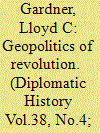

|
|
|
|
|
| Publication |
2014.
|
| Summary/Abstract |
How did the First World War affect the writing of history? Did historians begin to conceptualize history, in particular modern world history, differently after 1918?
|
|
|
|
|
|
|
|
|
|
|
|
|
|
|
|
| 14 |
ID:
133011
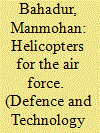

|
|
|
|
|
| Publication |
2014.
|
| Summary/Abstract |
On 10 March '2014,'the 104 helicopter Squadron of the Indian Air Force celebrated its Platinum Jubilee with a get together at Suratgarh where the Squadron is based. While the Platinum lubilee celebration of any ?ying outfit is an occasion to celebrate, there was a bigger reason for the commemorat' - it was also the day 60 years ago,w]_1 0 ' l" ' I first helicopter entered the in military service in India. And, just a few days later on 28 March 1954, Pandit Iawaharlal Nehru came to Palam and was flown to Tilpat range for the fire power demo of the IAF. So, like in everything connected with air power of the nation, the lAF was a trailblazer in the Rotary Wing field too.
|
|
|
|
|
|
|
|
|
|
|
|
|
|
|
|
| 15 |
ID:
132712
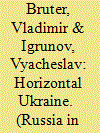

|
|
|
|
|
| Publication |
2014.
|
| Summary/Abstract |
The participation of Donetsk representatives in the government corresponds to the "horizontal principle," but domination does not. There will be neither real reform nor a modern and efficient state in Ukraine unless regions feel that they are equal.
|
|
|
|
|
|
|
|
|
|
|
|
|
|
|
|
| 16 |
ID:
139188
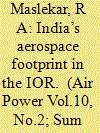

|
|
|
|
|
| Summary/Abstract |
The India Ocean Region (IOR), while being a major source for energy security and trade, is also a cauldron of instability due to conflicts, piracy and terrorism. The major power consider the IOR to be of great strategic significance. China too, is steadily enhancing its footprint in the IOR. India’s geographical location gives it a natural influential position over the major sea lines of communication and choke points in the Indian Ocean. Its aerospace capabilities are vital elements of national power for securing interests in the region. Hence, these capabilities need to be developed and acquired to match the imperatives of the time.
|
|
|
|
|
|
|
|
|
|
|
|
|
|
|
|
| 17 |
ID:
134040
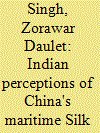

|
|
|
|
|
| Publication |
2014.
|
| Summary/Abstract |
The Maritime Silk Road (MSR) idea is part of this wider attemptby China to construct multiple lines of communication to its economicheartland in eastern China since the early 2000s. The underlying aim ofsuch a geostrategy is to also develop inner Chinese provinces and shapeChina's regional periphery by exercising economic, political and cultural Influence.
In May 2014, Xinhua unveiled maps showing China's ambitious Landand Maritime Silk Roads.3 The MSR envisions an 'economic cooperationarea' stretching from the Western Pacific to the Baltic Sea as a sort ofmaritime highway buttressed by Chinese-supported infrastructure andport facilities in states straddling maritime routes along which China'strade and natural resources flow.
|
|
|
|
|
|
|
|
|
|
|
|
|
|
|
|
| 18 |
ID:
134039
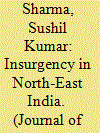

|
|
|
|
|
| Publication |
2014.
|
| Summary/Abstract |
State and non-state elements in India's neighbourhood have beensupporting insurgency in the North-East to weaken the Indian state. Inthe 1960s and 1970s, insurgents from the region, particularly the Nagarebels, had received moral and material support from China. Moreover,elements in Pakistan and Bangladesh too have been aiding North-EastIndian insurgents from time to time. The sanctuaries in Bhutan andMyanmar have emerged out of the inability of their governments toadequately administer the border areas or deal effectively with the hostileactivities of the Indian insurgents inside their respective territories. Thisarticle examines the role played by various external powers in sustain inginsurgency in the North-East, the changing external dynamics, andprovides a road map for future.
|
|
|
|
|
|
|
|
|
|
|
|
|
|
|
|
| 19 |
ID:
133675
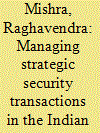

|
|
|
|
|
| Publication |
2014.
|
| Summary/Abstract |
The Indian Ocean Region (IOR) presents a unique tapestry of correspondences and divergences, positive and negatives, in an era of flux with world order, most likely, on the cusp of a systemic reordering. The geo-strategic salience of this region, as part of a larger global maritime continuum, has also increased. Strategic hedging behaviour by major stakeholders, resident and non-resident alike; besides securitisation of geo-political discourse that focuses on competitive aspects also present distinctive challenges for evolving a cooperative framework tailored to regional needs. The key issues examined for obtaining a pan-regional politico-strategic rapprochement are the tenets of critical geopolitics, game theory, geography, context and the efficacy of existing multilateral mechanisms, especially Indian Ocean Rim Association (IORA). The overall aim is to examine the various intertwined threads for formulating an inclusive and multi-sectoral maritime security framework with an IOR contextualisation.
|
|
|
|
|
|
|
|
|
|
|
|
|
|
|
|
| 20 |
ID:
021741
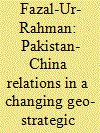

|
|
|
|
|
| Publication |
Summer 2002.
|
| Description |
37-61
|
|
|
|
|
|
|
|
|
|
|
|
|
|
|
|
|
|
|
|
|